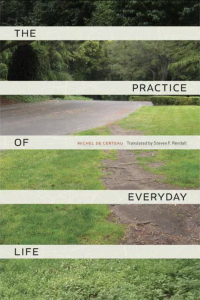In Spatial Stories, Certeau considers everyday life as a narrative story, everyday space as a location, a stage of the story. “Every story is a travel story—- a spatial practice. ” Admittedly, there are many spatial practices run through a story, either in physical or ideological forms. Thus, Certeau distinguishes the two nouns that are “space” and “place”. To simplify, “place” as “geometrical space”( Merleau-Ponty, as cited in Certeau), it is related to the objective existence. While “space” refers to the experience of sites, it is more a sense than a matter, on which travelling and moving converge. As for the spatial narrativity, Certeau uses two concepts, “tour” and “map”, to distinct the methods of spatial description, proposed by C. Linde and W. Labov. Tour tells more details about the process while the map emphasizes physical aspects, such as route, destination, and so forth. Based on the former theory, Certeau also mentions about boundaries, frontier and bridge of space and place. It provides a new view, from which space has the delimitation to make it unique among others, but not be fixed by its and show the flexibility that can hold the external.
I feel a sense of humanism through its rational analysis of the relationship between daily life and narrative space.
ZHANG, Qinya 3035639185 Fri11:00

A good and detail break down of Certeau’s theory of spaces and places and his idea on travel and map. Good Job.